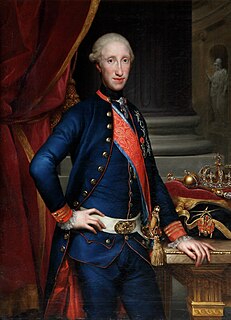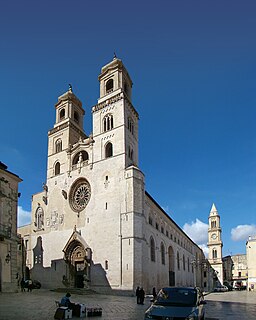
Naples is the regional capital of Campania and the third-largest city of Italy, after Rome and Milan, with a population of 967,069 within the city's administrative limits as of 2017. Its province-level municipality is the third-most populous metropolitan city in Italy with a population of 3,115,320 residents, and its metropolitan area is the second-most populous metropolitan area in Italy and the 7th-most populous urban area in the European Union.

Ferdinand I, was the King of the Two Sicilies from 1816, after his restoration following victory in the Napoleonic Wars. Before that he had been, since 1759, Ferdinand IV of the Kingdom of Naples and Ferdinand III of the Kingdom of Sicily. He was also King of Gozo. He was deposed twice from the throne of Naples: once by the revolutionary Parthenopean Republic for six months in 1799 and again by Napoleon in 1805.

The Parthenopean Republic was a semi-autonomous Republic located within the Kingdom of Naples and supported by the French First Republic. The republic emerged during the French Revolutionary Wars after King Ferdinand IV fled before advancing French troops. The republic existed from 21 January to 13 June 1799, collapsing when Ferdinand returned to restore monarchial authority and forcibly subdued republican activities.

Jean-Étienne Vachier Championnet, also known as Championnet, led a Republican French division in many important battles during the French Revolutionary Wars. He became commander-in-chief of the Army of Rome in 1798 and of the Army of Italy in 1799. He died in early 1800 of typhus. His name is one of the names inscribed under the Arc de Triomphe, on Column 3.

Guglielmo Pepe was an Italian general and patriot. He was brother to Florestano Pepe and cousin to Gabriele Pepe. He was married to Mary Ann Coventry, a Scottish woman who was the widow of John Borthwick Gilchrist, linguist and surgeon to the East India Company.

The Expedition of the Thousand was an event of the Italian Risorgimento that took place in 1860. A corps of volunteers led by Giuseppe Garibaldi sailed from Quarto, near Genoa and landed in Marsala, Sicily, in order to conquer the Kingdom of the Two Sicilies, ruled by the House of Bourbon-Two Sicilies.

Piazza della Signoria is an L-shaped square in front of the Palazzo Vecchio in Florence, Italy. It was named after the Palazzo della Signoria, also called Palazzo Vecchio. It is the main point of the origin and history of the Florentine Republic and still maintains its reputation as the political focus of the city. It is the meeting place of Florentines as well as the numerous tourists, located near Palazzo Vecchio and Piazza del Duomo and gateway to Uffizi Gallery.

Enrico Cosenz was an Italian soldier born at Gaeta.

Piazza del Plebiscito is a large public square in central Naples, Italy.

Eleonora Anna Maria Felice de Fonseca Pimentel was an Italian poet and revolutionary connected with the Neapolitan revolution and subsequent short-lived Neapolitan Republic of 1799, a sister republic of the French Republic and one of many set up in the 1790s in Europe.
Naples has played an important and vibrant role over the centuries not just in the music of Italy, but in the general history of western European musical traditions. This influence extends from the early music conservatories in the 16th century through the music of Alessandro Scarlatti during the Baroque period and the comic operas of Pergolesi, Piccinni and, eventually, Rossini and Mozart. The vitality of Neapolitan popular music from the late 19th century has made such songs as 'O Sole mio and Funiculì Funiculà a permanent part of our musical consciousness.

The Sicilian revolution of independence of 1848 occurred in a year replete with revolutions and popular revolts. It commenced on 12 January 1848, and therefore was the first of the numerous revolutions to occur that year. Three revolutions against Bourbon rule had previously occurred on the island of Sicily starting from 1800: this final one resulted in an independent state surviving for 16 months. The constitution that survived the 16 months was quite advanced for its time in liberal democratic terms, as was the proposal of an Italian confederation of states. It was in effect a curtain raiser to the end of the Bourbon kingdom of the Two Sicilies which was started by Giuseppe Garibaldi's Expedition of the Thousand in 1860 and culminated with the Siege of Gaeta of 1860–1861.

Gesù Nuovo is the name of a church and a square in Naples, Italy. They are located just outside the western boundary of the historic center of the city. To the southeast of the spire, one can see a block away the Fountain of Monteoliveto and the piazza of the church of Sant'Anna dei Lombardi. The square is a result of the expansion of the city to the west beginning in the early 16th century under the rule of Spanish viceroy Pedro Alvarez de Toledo. The square of Gesù Nuovo contains three prominent landmarks:

Florestano Pepe was an Italian patriot. He was brother to the more famous general Guglielmo Pepe and cousin to Gabriele Pepe.

Stanislao Lista was an Italian sculptor active in Naples.
Giuseppe Bardari was an Italian lawyer and writer. Although chiefly known today for having written the libretto for Donizetti's 1835 opera, Maria Stuarda, he played a prominent role in the judiciary of Naples in the years leading up to the unification of Italy.
Vincenzo Russo was an Italian patriot, who was a leading supporter of the short-lived Parthenopean Republic. Captured by the Sanfedista forces, he was soon executed along with many other rebels of the Bourbon rule of Ferdinand IV of Naples.

The Bourbon Tunnel, Tunnel Borbonico or Bourbon Gallery is an ancient underground passage, constructed for military purposes to connect the Royal Palace to military barracks in Naples, Italy.

Tommaso Solari was an Italian sculptor active in a Romantic-style.

Piazza del Duomo is the main square of the city of Altamura, Italy. It is located in the center of the historic city center, as well as in the middle of the main street of the city, that is corso Federico II di Svevia. Moreover, Altamura Cathedral, the main church of the city, is located on the square. It is also known because the Tree of Liberty was planted in this square during the so-called Altamuran Revolution (1799).





















